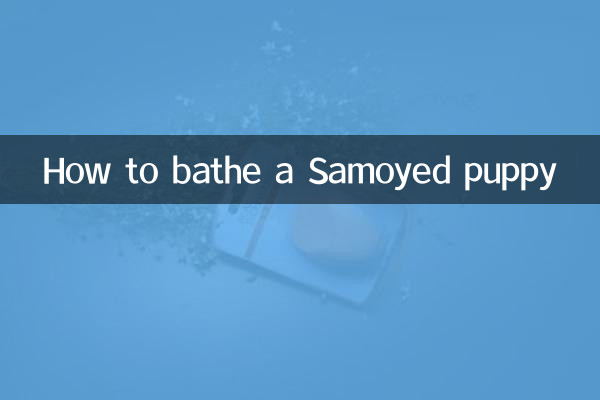How to bathe a Samoyed puppy
In the past 10 days, among the hot topics on pet care on the Internet, the bathing method of Samoyed puppies has become the focus of many novice owners. Samoyeds are well-loved for their snow-white coats and friendly personalities, but bathing care for puppies requires special attention. This article will introduce in detail the steps, precautions and FAQs for bathing Samoyed puppies to help you complete this task easily.
1. Preparations before bathing Samoyed puppies

Before bathing a Samoyed puppy, you need to make the following preparations to ensure a smooth and safe bathing process:
| Items | Purpose |
|---|---|
| Shower gel for pets | Avoid using human body wash to prevent skin irritation |
| Warm water (about 38°C) | The water temperature should not be too high or too low to avoid irritating the puppy’s skin. |
| Towels and hairdryer | Used for drying and blow-drying hair to prevent colds |
| comb | Comb your hair before bathing to avoid tangles |
| Anti-slip mat | Place in the bathtub or bathtub to prevent puppies from slipping |
2. Bathing steps for Samoyed puppies
The following are the specific steps for bathing a Samoyed puppy. Following the order can ensure that the bathing process is efficient and safe:
| steps | Operating Instructions |
|---|---|
| 1. Comb hair | Use a comb to comb your hair before bathing to remove dead hair and tangles |
| 2. Adjust water temperature | Adjust the water temperature to about 38°C and test whether the water temperature is suitable with the inside of your wrist |
| 3. Wet hair | Gently wet the puppy's body with warm water, avoiding direct showering on the head. |
| 4. Apply shower gel | Take an appropriate amount of pet shower gel, rub it into foam and apply it evenly on the hair. |
| 5. Gentle massage | Use your fingertips to gently massage the skin, especially the soles of the feet and abdomen, which are prone to dirt. |
| 6. Rinse clean | Rinse hair thoroughly with warm water, making sure there is no body wash residue |
| 7. Dry and blow dry | First use a towel to absorb the moisture, then blow dry with a hair dryer at low temperature to avoid high temperature burns |
3. Precautions for bathing Samoyed puppies
When bathing a Samoyed puppy, you need to pay attention to the following things to avoid causing harm or discomfort to the puppy:
| Things to note | Description |
|---|---|
| Bath frequency | 1-2 times a month, too often will destroy the skin's oil balance |
| Avoid water entering the ears | Use cotton balls to plug your ears when taking a bath to prevent water from getting in and causing otitis |
| Do not use human body wash | The pH value of human body wash is not suitable for dogs and may cause skin problems |
| Keep the environment warm | Blow dry the hair promptly after bathing to prevent the puppy from catching cold |
| Observe skin condition | After bathing, check the skin for redness, swelling or abnormalities and deal with them promptly. |
4. Frequently Asked Questions
The following are frequently asked questions and answers about bathing Samoyed puppies to help you better deal with practical questions:
| question | Answer |
|---|---|
| How old do puppies need to be bathed? | It is recommended that puppies be bathed after they have completed their vaccinations (approximately 3 months old) |
| What should I do if my puppy doesn’t cooperate during bathing? | You can use snacks or toys to distract your attention and gradually adapt to the bathing environment |
| How to deal with severely tangled hair? | Use a knotting comb to comb it before taking a bath. If you have severe knots, please consult a professional beautician. |
| What should I do if my puppy scratches its skin after bathing? | It may be due to shower gel residue or skin allergies. It is recommended to rinse it off and observe. |
Through the above detailed steps and precautions, I believe you have mastered the correct method of bathing a Samoyed puppy. Regular bathing not only keeps your Samoyed's coat white and fluffy, but also promotes healthy skin. If you have further questions, you can consult a professional pet groomer or veterinarian.

check the details

check the details